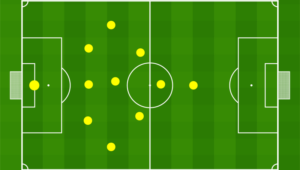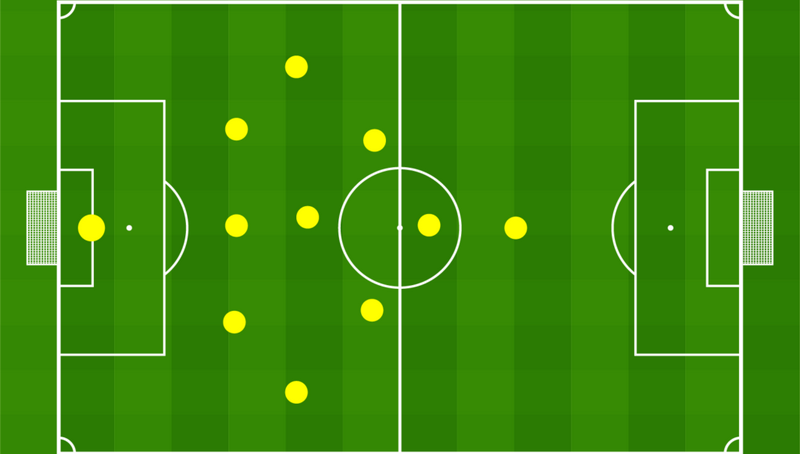In the ever-evolving world of football, the debate surrounding the validity and effectiveness of one football tactics and formations over another has been a constant source of fascination for fans and coaches alike. From the classic 4-4-2 to the more modern 4-2-3-1, the sport has witnessed a continuous cycle of innovation and reinvention as teams strive to gain a competitive edge.
This relentless pursuit of tactical superiority is one of the primary drivers behind the constant evolution of the game. A coach who can implement a football tactics and formations strategy that their peers are unfamiliar with can gain a significant advantage over their opponents. In this comprehensive guide, we delve into some of the most popular football tactics and formations in the game today, highlighting their strengths, weaknesses, and the best ways to counter them.
Table of Contents
ToggleThe Most Common Systems – And How to Beat Them
1. 4-4-2
One of the oldest football tactics and formations still in regular use today, the 4-4-2 is often associated with the English game. While it may be considered a more simplistic approach, a well-drilled team can still find success through this system.Strengths:
- Easy to understand and implement, making it a reliable choice for teams with limited tactical complexity.
- The two-striker partnership can create problems for opposing defenses, especially if they have a good understanding and complementary skill sets.
- The four-man midfield provides a solid defensive foundation while still allowing for some attacking threat.
Weaknesses:
- Lacks the sophistication and passing angles offered by more modern football tactics and formations, which can make it easier for opponents to nullify.
- The two-striker partnership can sometimes lead to a lack of width and creativity in the final third.
- The midfield can become overcrowded, making it difficult to maintain possession and control the tempo of the game.
How to Beat It:
- Exploit the lack of width by using pacy wingers or overlapping full-backs to stretch the defense.
- Dominate possession and control the tempo of the game, forcing the 4-4-2 team to chase the ball.
- Utilize a midfield trio to outnumber the opposition’s central midfielders and dictate the flow of the game.
Read Also: Claim Free Credit RM10: Top Platforms with Free Bonuses in Malaysia
2. 4-3-3
The 4-3-3 football tactics and formations is a more modern and versatile system that has gained widespread popularity in recent years.Strengths:
- Provides a good balance between attack and defense, with the three-man midfield offering both creativity and defensive solidity.
- The three-pronged attack can be difficult for opposing defenses to mark, especially if the wingers are adept at cutting inside and creating chances.
- Allows for a high-pressing, counter-attacking style of play that can be effective against teams that dominate possession.
Weaknesses:
- The wide attackers can sometimes be isolated, especially if the full-backs are not providing adequate support.
- The three-man midfield can be overrun by a more compact, disciplined opponent that is able to control the tempo of the game.
- Requires a high level of fitness and discipline from the players to maintain the intensity of the pressing game throughout the match.
How to Beat It:
- Exploit the space behind the full-backs by using pacy, direct wingers or overlapping runs from midfielders.
- Dominate possession and control the tempo of the game, forcing the 4-3-3 team to chase the ball.
- Use a compact, disciplined defensive shape to nullify the threat of the three-pronged attack and force the wide players to come inside, where they can be more easily marked.

3. 4-2-3-1
The 4-2-3-1 football tactics and formations has become one of the most popular systems in modern football, offering a balance between defensive solidity and attacking threat.Strengths:
- The two defensive midfielders provide a solid foundation, allowing the attacking players to focus on creating chances.
- The three attacking midfielders offer a variety of options, with the ability to switch positions and create overloads in the final third.
- The lone striker can be a focal point for the attack, with the supporting midfielders providing service and creating space for them to operate.
Weaknesses:
- The two defensive midfielders can sometimes become too passive, allowing the opposition to dominate possession and control the tempo of the game.
- The attacking midfielders may struggle to find space if the opposition is well-organized and disciplined in their defensive shape.
- The lone striker can become isolated if the supporting midfielders are not providing adequate support.
How to Beat It:
- Exploit the space between the defensive midfielders and the back four, using quick, direct passing to create scoring opportunities.
- Press the attacking midfielders high up the pitch, disrupting their ability to receive the ball and turn.
- Use a physical, aggressive striker who can hold up the ball and bring the supporting midfielders into play, preventing the opposition from dominating possession.

4. 4-5-1 (+ 4-1-4-1)
The 4-5-1 football tactics and formations, and its variation the 4-1-4-1, are often employed by teams looking to avoid defeat in knockout competitions or against more dominant opponents.Strengths:
- The five-man midfield provides excellent defensive cover, making it difficult for opponents to penetrate the lines.
- The team can easily transition between a 4-5-1 and a 4-3-3 or 4-2-3-1 by adjusting the positioning of the wide midfielders.
- The formation allows for effective possession-based play, with the midfielders able to control the tempo of the game.
Weaknesses:
- The lone striker can become isolated, with the midfielders not always providing adequate support in the final third.
- The team may struggle to create clear-cut scoring opportunities, relying more on set-pieces or counter-attacks.
- The defensive focus can sometimes come at the expense of attacking threat, making it difficult to break down well-organized opponents.
Read Also: Odibets Registration Guide 2024: How to Register & Login in Kenya
How to Beat It:
- Exploit the space behind the midfielders by using pacy, direct wingers or overlapping full-backs.
- Press the lone striker high up the pitch, forcing the team to play long balls that can be easily won by the defense.
- Use a high-tempo, possession-based game to tire out the opposition and create gaps in their defensive shape.
Conclusion
The constant evolution of football tactics and formations is a testament to the sport’s enduring appeal and the ingenuity of its coaches. As teams continue to push the boundaries of tactical innovation, it will be fascinating to see which systems emerge as the dominant forces in the game.By understanding the strengths and weaknesses of the most common football tactics and formations, coaches and teams can better prepare to counter their opponents’ strategies and gain a competitive edge.
Whether it’s exploiting the space behind the full-backs or dominating possession to nullify a compact defensive shape, the key to success lies in the ability to adapt and outmaneuver the opposition.As the game continues to evolve, the debate surrounding the best football tactics and formations will undoubtedly rage on. But one thing is certain: the pursuit of tactical superiority will remain a driving force behind the constant reinvention of the beautiful game.
Trust you found our article on “Football tactics and formations explained: the most common systems – and how to beat them″ helpful please follow our website for more interesting and informative articles like this.

